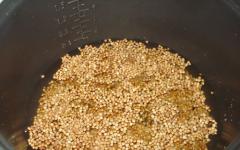But what if the orchid has rotted all the roots or most of them? Is it possible to restore health to the plant or will you have to say goodbye to the green pet?
After removing problem areas, the sections on the remaining parts are necessarily treated with activated carbon crushed to the stage of powder or ground cinnamon, which also has pronounced disinfecting properties. When the roots are dry, it is useful to immerse them in a fungicide solution for 10-15 minutes. This will reduce the risk of harmful fungi colonizing the weakened plant.
After disinfecting the remnants of the roots, ensuring the protection of the plant, it is important to treat the growth zone of future roots with a growth stimulator. This will strengthen the orchid's immune system and speed up rooting.
How to revive an orchid: methods available at home
An orchid left without roots should not be thrown away. A tropical plant, with proper care and patience, turns out to be very hardy and life-loving. Experienced florists are advised to consider three ways to revitalize:
- in a home greenhouse;
- without a greenhouse, using regular watering and drying;
- by planting in a regular substrate.
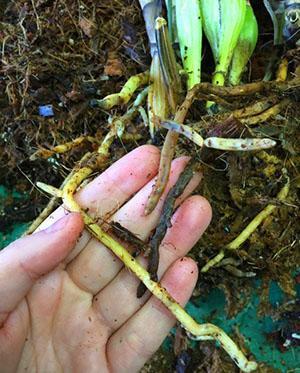 Before reanimating an orchid, you need to assess its condition and choose the most effective and fastest way. If a flower that has lost less than 60% of its roots manages to regain health in a month, then an orchid completely devoid of its root system may require special maintenance and care for up to a year.
Before reanimating an orchid, you need to assess its condition and choose the most effective and fastest way. If a flower that has lost less than 60% of its roots manages to regain health in a month, then an orchid completely devoid of its root system may require special maintenance and care for up to a year.
The choice of how to save an orchid without roots depends on:
- from the condition of the affected flower;
- on the number and condition of leaves;
- from the presence of horse rudiments formed in the lower part of the leaf rosette.
Of no small importance are the conditions that a florist can create for the resuscitation of an orchid without roots.
How to reanimate an orchid in greenhouse conditions?
If the grower has a window greenhouse in which the plant will be kept at a consistently high humidity and comfortable temperature, there is a high probability of saving even a seriously weakened flower without a root system.
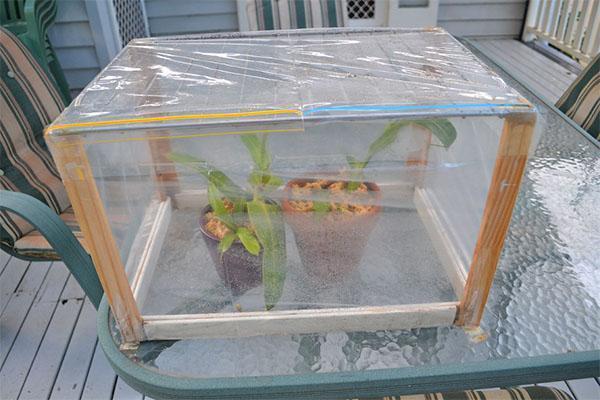 How to reanimate an orchid if the roots have rotted? In the container in which the flower is to be rooted:
How to reanimate an orchid if the roots have rotted? In the container in which the flower is to be rooted:
- a thin layer of expanded clay is poured;
- a layer of cleaned, thoroughly steamed sphagnum is laid on top of it.
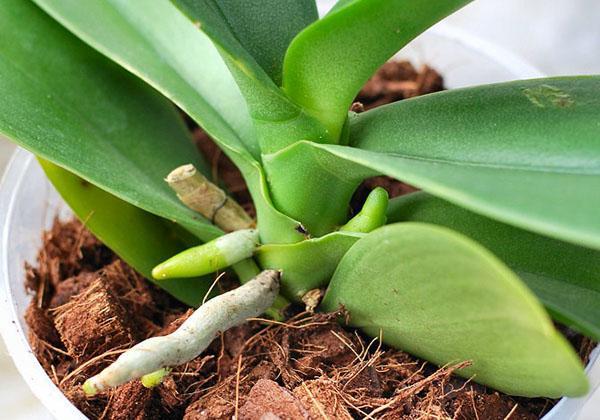 The substrate is carefully moistened and a leaf rosette is placed in it. Until the plant has 3–5 cm long roots, the flower will have to be constantly under cover:
The substrate is carefully moistened and a leaf rosette is placed in it. Until the plant has 3–5 cm long roots, the flower will have to be constantly under cover:
- at air temperatures from 22 to 28 ° C;
- at air humidity within 70-100%;
- in bright diffused lighting for 12-14 hours a day.
Temperatures below 20 and above 33 ° C inhibit the growth of roots, but promotes the reproduction of pathogenic flora and fungi.
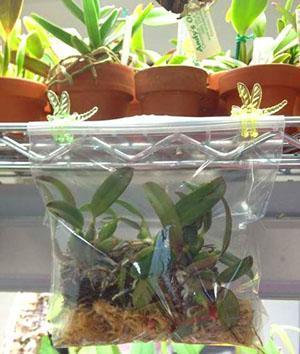 What if all the roots of an orchid have rotted? Can root formation be stimulated? Yes, this can be done with the help of competent care of the leaf outlet in the greenhouse. As necessary, the substrate is slightly moistened, and the greenhouse is ventilated. This is best done at night, which contributes to the saturation of the air with carbon dioxide and makes the rudiments of a future healthy root system form faster.
What if all the roots of an orchid have rotted? Can root formation be stimulated? Yes, this can be done with the help of competent care of the leaf outlet in the greenhouse. As necessary, the substrate is slightly moistened, and the greenhouse is ventilated. This is best done at night, which contributes to the saturation of the air with carbon dioxide and makes the rudiments of a future healthy root system form faster.
The success of rooting depends on observing the temperature regime, maintaining a long daylight hours and high humidity for an apartment. While the orchid is in the greenhouse, the outlet should be regularly inspected to prevent the appearance of foci of rot.
 In four out of five cases, using this method, you can save an orchid without roots, and signs of the formation of a new root system become visible after 10-14 days. And plants with roots 3-4 cm in length are planted in an ordinary substrate and transferred to the usual conditions for a flower.
In four out of five cases, using this method, you can save an orchid without roots, and signs of the formation of a new root system become visible after 10-14 days. And plants with roots 3-4 cm in length are planted in an ordinary substrate and transferred to the usual conditions for a flower.
How to save an orchid without using a greenhouse?
As in the previous case, the plant is rooted at a temperature of 20 to 27 ° C, in a place shaded from direct sunlight. But how to reanimate an orchid in this case, when there is no home greenhouse or greenhouse?
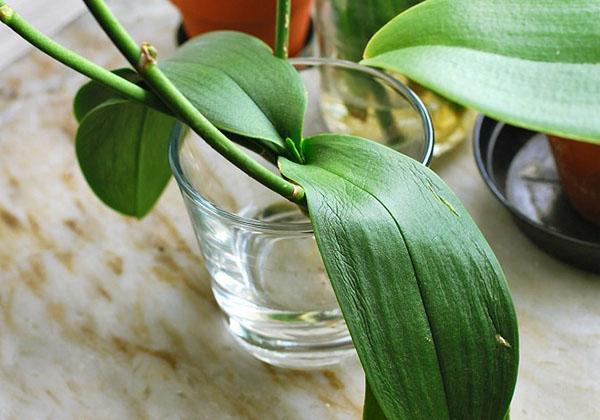 The pre-treated rosette is placed in a deep glass vessel. Every day, in the morning hours, soft, boiled or filtered water is poured into it so that its surface touches only the lower part of the remaining root system and does not wet the leaves. In this form, the orchid remains up to 6 hours. Then the water is drained, and the flower is dried until the next morning.
The pre-treated rosette is placed in a deep glass vessel. Every day, in the morning hours, soft, boiled or filtered water is poured into it so that its surface touches only the lower part of the remaining root system and does not wet the leaves. In this form, the orchid remains up to 6 hours. Then the water is drained, and the flower is dried until the next morning.
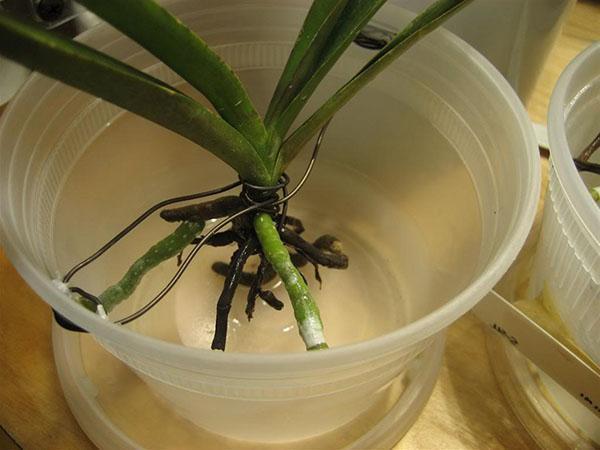 There is one feature, how to revive an orchid without roots faster and more efficiently.
There is one feature, how to revive an orchid without roots faster and more efficiently.
A teaspoon of honey or sugar syrup is added to the water per liter of liquid. In addition, to moisten the substrate or watering all reanimated orchids, it is useful to use:
- specialized in very low concentration;
- feeding with an iron preparation;
- monthly treatments with growth regulator.
How to revive an orchid that has not lost all its roots, but only a part of them? In this case, the plant is still able to feed in the usual way, so you can grow the missing roots by planting the flower in a pot 6–8 cm in diameter with an ordinary substrate. Lighting for 12 hours and a temperature of 20-25 ° C will make the root buds activate. At night, the temperature should not drop, and the humidity is maintained at an elevated level.
 Instead of watering, small-drop irrigation of the upper layer of the substrate is used or a container with an orchid is placed in a pan with a small amount of water for half an hour. Moisten the soil again only after it is completely dry. New root growth begins in 1–4 weeks.
Instead of watering, small-drop irrigation of the upper layer of the substrate is used or a container with an orchid is placed in a pan with a small amount of water for half an hour. Moisten the soil again only after it is completely dry. New root growth begins in 1–4 weeks.
A video on how to save an orchid if the roots have rotted and the plant has lost the opportunity to receive moisture and nutrition will help clarify all the nuances of a complex procedure. Thorough theoretical preparation will not allow you to make mistakes in practice, and soon your favorite flower will again become an adornment of your home collection.









